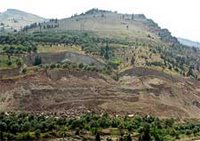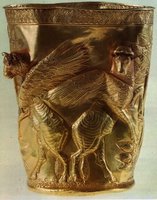Kadusi Governmental Citadel Discovered in Gilan

Tehran, 18 January 2006 (CHN) -- Archeological studies in Kaluraz Tepe in Gilan province indicated that this historical site was once the governmental citadel of Kadusi people. Being used as a border guard, it prohibited the invasion of Amarta and Marlik people to this region. The first season of archeological excavations in Kaluraz Tepe led to the discovery of the first architectural plan belonging to the Iron Age (800-550BC). There is a construction with big halls and several rooms in this historical site. Kaluraz historical hill, located in Rostam Abad, is the most ancient historical site of Gilan province. This historical site was once excavated by Iranian archeologists in the 1960s, but since it belonged to an official authority of the previous regime, archeological excavations had stopped until recently. Finally, last year digging boring pits and stratigraphy works started on this site.
“The discoveries during the first season of excavation in Kaluraz Tepe indicate that this hill could not have been the residence of ordinary people or even the aristocrats of the society. The 2-meter shell-keep surrounding the hill and the halls as well as the intricate rooms with brick floors all indicate that this complex should have been the residence of prominent social classes. Considering these evidences and that this historical site was a frontier area during Kadusi era, prove the fact that Kaluraz was a governmental citadel which also played a defense role,” says Mohammad Reza Khalatbari, director of the pre-historic unit of the Archeological Research Center and head of Kaluraz excavation team.
According to Khalatbari, Sefidrud River has always played an important role in shaping the culture and civilization in Gilan province. “During the middle ages, Sefidrud River divided Gilan province into two sections of biapas and biapish regions, with Lahijan and Fooman being their capital cities. Prior to this and during the first millennium BC, the river had separated Gilan province into two parts. The eastern section was captured by Amarta people, and the western section by Kadusi people. The latter was located at the present-day Talesh region,” added Khalatbari.
Khalatbari believes that Kaluraz and also the Pila fortress located in Marlik historical
 site in west and east of Sefidrud River were two governmental citadels which were established on the frontier zone of this river to protect Kadusi and Amarta borders.
site in west and east of Sefidrud River were two governmental citadels which were established on the frontier zone of this river to protect Kadusi and Amarta borders.Marlik Tepe, which is considered as the first cemetery of the inhabitants of Pila fortress, is one of the most important historical sites of Iran which was excavated by Ezatollah Negahban in 1961. Marlik bowl is one of the most valuable Iranian historical relics found in the region.
Archeologists believe that most probably Kadusi and Amarta people had got into conflicts and the governmental citadels were constructed on the Sefidrud River’s frontier zone to protect the borders between these two tribes.
Most parts of Kaluraz architectural construction is made of earthen and stones which have also been used in some parts including the shell-keeps.

2 Comments:
I wonder why human are obsessed about to know from where they come... I mean supposedly everything starts with the big ban... no one can prove that is just a theory, or fine the world was just created 5 minutes ago, i don't understand why humans are like this, they are just bore.
This blog post provides fascinating insights into ancient Iranian history.
Post a Comment
<< Home